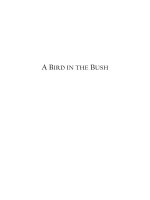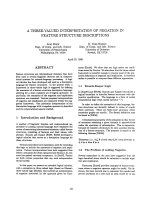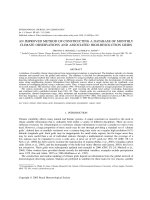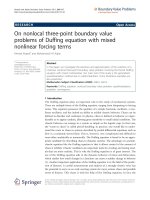A w cohen three point reversal method of point figure stock market trading
Bạn đang xem bản rút gọn của tài liệu. Xem và tải ngay bản đầy đủ của tài liệu tại đây (11.56 MB, 132 trang )
6nt
HOWTO
USETHE
Three-Point Reyersal Method of
Pof,mt6
Sfock Market Trading
BY A. W. GOHE]I
onraruAt rnte )
ffi@ffiM'
ilETH0D
0Fp0tXT
& FIOURE
TRADITO
PUBL'ST]ED AV}
GHARTCRAFT,
IJIG.
LARGHM||JIT,
JI.Y.
FOR SALE & EXCHANGE
www.trading-software-collection.com
Subscribe for FREE download more stuff.
Mirrors:
www.forex-warez.com
www.traders-software.com
Contacts
Skype: andreybbrv
ICQ: 70966433
)
)
I
I
t
t,
r
I
It
)
I
t
HOW TO USE THE
Three-Point ReversalMethod of
I
I'
Pof,nt{P
-(d-(L?
Sfock Market Trading
BY A. W. COHE]I
A TECIIIIICAI.
APPR(IACH
I|l ST(ICT
ilARI(IIIRIIIIIIG
P U B T I S HBEYDC H A R T C R A
I iF
l CT. ,T A R C H I I ( l 1} II T.Y,.I 0 5 3 8
1968,1978,1982,& 19&4by Chartcraft,[nc.
Copydght
nrUtisneaby Chartcraft,Inc., Larchmont,NY
Number:68-54093
Catalogue
Libraryof Congress
EIGHTH REVISED EDITION
The material containedherein is not to be taken as advice to buy or sell
specific securities. The information presented is based on sources we
and
Ultieveto be reliableand hasbeencarefullycheckedfor completeness
guaranteed.
be
accuracy,but cannot
TABLE
OF CONTENTS
Page
Foreword
D
Introduction
6
Section One - The Poj.nt & Figure Chart and Construction
The Point & Figure Chart
Charting A Very Low-Priced Stock
Chart Construction
The Double Top & Double Bottom Formation (# 1)
The Double Top & Double Bottom Formation (#2)
The Bullish Signal Formation
The Bearish Signal Formation
The Bullish & Bearish Symmetrical TriangLes
The Triple Top Formation . .
The Triple Bottom Formation
Formations In Combination
Variations On The Triple Top & Triple Bottom Formations
The Broadening Formation
The Spread Triple Top & Bottom Formations .
Bullish & Bearish Cataputt Formations .
The Bearish & Bullish Signal Reversed F'ormations .
Section Three - Trend Lines
The Bullish Support Line
The Bullish Resistance Line
The Bearish Resistance Line
The Bearish Support Line
n
a
B
11
L2
15
16
18
20
.
22
24
26
2B
30
32
34
36
3B
40
43
44
48
50
53
Section Four - Price Objectives .
The Horizontal Count
The Vertical Count
The Horizontal & Vertical Count
5B
60
Section Five - Relative Strength
61
Section Six - Industry Groups .
65
Section Seven - The Dow-Jones Industrial Average
69
Section Eight - Trading Tactics
Establishing The Trade
Profitability Tables
The Pu]lback
Profitability Tables
Stoploss Orders
Taking Profits
73
74
74
75
76
77
78
55
Db
SectionEight (continued)
StocksWith A High Short Interest.
Volume.
80
80
SectionNine - ConvertibleBonds .
E1
SectionTen - Over-The-Counters.
85
SectionEleven - TechnicalIndicators
The CumulativeDaily Advance-DeclineLine .
The High-Low Index
The On-BalanceVolumeIndex
The Odd-Iot BalanceIndex
The Odd-Lot Short Saleslndex
The 10-DayAdvance-DeclineRatio .
The 10-DayUpside-DownsideVolume Ratio
The 200-DayDJIA Momentum Index
The DJIA One-YearToChart .
The Index of SpeculativeConfidence
The Gold Mining Disparity lndex
The Short Interest Ratio .
The % of NYSE StocksAbove Their 10-WeekMoving Average '
The lO-WeekMost Active StocksRatio
The NYSE Bullish Percentage
The DJIA Bullish Percentage.
GeneralMotors as a Bellwether Stock.
89
90
91
92
93
94
95
96
97
98
99
100
101
r02
103
104
105
106
SectionTwelve- Puts and Calls .
107
SectionThirteen - Commodities.
113
SectionFourteen- Adjusting a Chart for a StockSplit
125
SectionFifteen - The S-PointReversalChart
126
-4-
FORWARD
The basicprinciples of "How to Use the Three-PointReversalMethod of Point & Figure StockMarket Trading" were ftrst published in 1947under the trtle "StockMarket Timing. " When the Chartcraft Weekly Service
was started in 1948,the name of the book was changedto "The ChartcraftMethod of Point & Figure Trading."
In August 197E,we publishedthe sixth revisededitionof this bookwhich includedrevisedchaptersdealingwith
the Dow'JonesIndustrial Average, Over-The-Counter
Stocks,and TechnicalIndicators.In March 1980,the
Seventheditionwaspublishedcontaininga revisedchapteron OptionTrading.
This is the eighth revisededition. It containsrevisedsectionson Price Objective,RelativeStrength,Technical Indicators,Options,and Commodities.
Althoughfuture editionsare constantlyin the planning,the basicprinciplesremainthe same.
Specialacknowledgment
is made to ProfessorRobertEarl Davisof PurdueUniversity.He was kind enough
to let us read his lengthy manuscript, "Proft and hobability-Technical Analysis of the Price Fluctuations of
'
CommonStocks,' and haspermittedus to usehis figureson the profit potentialof the varioustrading formations
containedin this book. All the formationswere programmedfor an IBM 7094computerand the results were
obtainedon the basisof tradingfrom buy signalto sellsignal,and sell signalto buy signal,with trend lines taken
into account,
A. W. Cohen
July 1982
INTRODUCTION - THE TWO APPROACHES
ar companycanbeapproached
T h e p r o b l e m o f t h e p u r c h a s e o f s t o c k i n a n y p a r t i c u l"should
I buy the stock of
problem
as:
pose
the
to
is
way
in either of two ways. One
"When shall I buy the stock
theXyZ Companyi" The other is to pose the problem as:
of the XYZ ComPanY?"
"Should I?" is taking the fundamental approach
The person who asks the question
"When shall I?" is
to the stock market analysis. The person who asks the question
taking the technical approach to stock market analysis'
The fundamental analyst concerns himself with financial statements, history,
position
quality of management, earnings, dividends, popularity of products, relative
in the industry,. etc.
The technical analyst concerns himself with suppiy and demand, accumulation
have substantial moves at one time or another'
and distribution. Practicaliy all stocks
"blue chip" as of a "cat and dog. " No stock goes up
Fluctuation in price is as true of a
goes up it goes through a period of accumuin price of its own accord. Before a stock
"insiders, rr it is passing from "weak hands" into "strong hands" until demand
trtio.r by
Bef.ore a stock drops in price'
is greater than supply and the upward move is on its.way'
"insiders. " It is passing from
it goes through " p""ioA of distribution by the same
"slrong handi" into "weak hands. " When support is withdrawn, supply overcomes
is concerned with
demand and the panicky downward move is on. The tecbnical analyst
to determine the
the right time to Uuy and the right time to sell short. He attempts
situation. He is an
moment when either supply or demand has taken control of the
"insiders" are doing'
,,outsider" making ,r"" oi various techniques to determine what the
a
When should a stock be bought? The broad answer to this question is that
stocks egeneralmarketisinanuptrend,(2)theindustry
group of which it is a member is in an uptrend, and (3) the stock itself is in an uptrend.
- the price of a market average, the price of
ffptrlnO, as used herein, refers to price
cash
the industry group index, the price of tne stock. It does not refer to earnings,
the
fJ.ow, growth, etc.; such factors may answer the question what to buv but never
question when to buY'
When should a stock be sold short ? The broad answer to this question is that
astockslrouIdu.@thegenera]marketisirradowntrend,(2)the
(3) the stock itself is
industry group of which it is a member is in a downtrend, and
side of the market
short
in a downtrend. The trader or investor who does not like the
should at Ieast be out of stocks in such a situation. Here again, downtrend refers only
to.price and nothing else.
The tools used by the technical analyst in nraking such determinations are
of
primarily charts - charts of a particular stock, charts of an industry group, charts
a market Average or Index. There are three types of charts: line, bar, and Point and
Figure. This book is devoted to Point and Figure charting and interpretation. It is
the oldest form of charting used in the stock market, it is indigenous to and grew out
of the stock market, and once n:astered and understood it is also the simplest and
clearest method of determining the right tinre to buy and the right tiure to sell. The
Point and Figure chart shouts where other charts merely stutter.
-6-
SECTION
ONE
THE POINT AND FIGURE CHART AND ITS CONSTRUCTION
In Figure # 1, we have a Point and Figure chart "under the aspect of eternity. "
By this, we mean that both vertical and horizontal coordinates are based on price
changes. In the usual line or bar chart, the vertical coordinate is based on price and
the horizontaL coordinate is based on time (day, week, or monttr). This is not the case
in a Point and Figure chart. Chronology has no significance in it. The only thing it
concerns itself with is a stockrs price changes independent of the time in which these
changes take place. The chart patterns that this chart develops are independent of the
time it takes for their eoming into being, whether it is a matter of days, weeks, months,
or years. Their significance for the future remains the same.
Although we will include chronological data in the body of the Point and Figure
chart, as wiLl be seen in the ensuing pages, this wilL be done merely to establish a
frame of reference.
THE POINT AND FIGURE CHART
Figure # 2 is a reproduction of a Point and Figure chart of Bucyrus-Erie.
us examine it closely and learn how it is constructed'
Let
Each square ( not line) on the chart represents a unit of price.
Under 20, each square stands for |-point or one-half dollar.
From 20 to 100, each square stands for 1-point or one dollar.
When the price of a stock is going up, we use Xs to indicate the price changes.
When the price of a stock is going down, we use 0s to indicate the price chatrges.
Vertical columns of Xs and 0s alternate. We n.roveone colutrln to the right
each time there is a change in direction - from up to down or from dorvn to up. Xs and
0s never appear in the same column. Each colun.tn represents either an upnlove or a
downmove, it cannot represent both. (Daily highs and lo'tls ale used fol determining
upmoves and downmoves and not closing prices).
-8-
In no vertical column are there ever less than 3 squares of Xs or 3 squares of 0s.
Thismeansthatinordertorecordacna@anupmovetoadownmove,
or vice versa, there must first be a price change equal to at Ieast 3 squares.
Over 20, therefore, a price change of 3 points or three dollars would be necessary
for a trend reversal. If the price of a stock has gone up to 50, it must go down to 47
before we car record the 0s in the next vertical column.
Under 20, a reversal of 1-j points or one-and-one-half dollars would be necessary. If the price of a stock has gone down to 14, it must go up to 15-| before we can
record the Xs in the next vertibd column.
At the borderline of ,20t 3 squanes may represent only 2 ot 2'l points, but a
reversal occupying 3 squares is drryays necessary.
In the same trend, however, each point or |-point
on lts way up or down.
is added as the stock continues
Over the 20 price square, we have'no fractions at all on our chart. If a stock has
gone up from 32 to 39-?/8, the highest X in our column will be in the 39 square. If a
stoct< has gone down from 57 to 43-1/B ttre lowest 0 in our column will be in the 44th
square (it never made an even 43).
Under the 20 price square) the only fractions we have are in |-point units. If a
stock has gone rpi"orn tO-i to L3-7 18, the highest X wilt be in the 13-| square; and
if it has gone down from 16 to 13-5/8, the lowest 0 will be in the 14 square (it never
made an even 1g-*).
Over 100, each square should represent 2 points or two dollars. The 3 squares
necessary for a trend reversal will therefore stand for 6 points or six dollars except,
of course, at the borderline of 100.
It is very important to indicate that a Point and Figure chart is a one-dimensional chart. In the usual stock market chart, whether bar or line, the vertical axis
represents price and the horizontal axis records time. In the Point and Figure chart
both the vertical and horizontal a:
may contain is of no importance either to its construction or interpretation.
we have indicated the
only as a matter of convenience. In the chart of Bucyrus-Erie,
passage of time by the numerals L to L2 (1 representing January, 2 representing
February, etu. ). The appropriate numeral has been substituted for an X or an 0 the
first time a price change is entered in a new month. When this coincides with a 3-box
price reversal, the numeral is entered in the third square up or down as the case
may be. Years are indicated at the foot of the chart. If all this chronological data
were omitted, the chart would be just as valid. The Point and Figure chart is indigenous to the stock market; it was used to graphicaUy record price changes, perhaps
as far back as the 1-880s. It is the oldest type of chart used in stock market trading.
lt, becauee of the 3-box
Ttre Polnt and Flgure chart, as ne have constnrcted
all mlnor and confuelng
elLmlnatee
dlrectLon,
for
ln
a change
rerrergal necessary
easlly to correct lnltself
It
lends
moves. It 18 eLople, clear and conclge.
and
malntaln.
to
conatnrct
It 18 sLnple
terpretatlon.
lfote: Charts compiled by Electronic Computer substitute A, B and C for 10,
as symbols for the months October, November and December.
12
11 and
-9-
Figure # 3 is a Point and Figure chart of Union Carbide.
of charting when the price of a stock rises and falls above 100.
It illustrates the units
Below 100, each square stands for 1-point or one dollar.
Above 100, each square stands for 2-points or two dollars.
A 3-box reversal below 100, would be equal to 3-boxes or three dollars.
A 3-box reversal above 100, would be equal to 6-points or six dollars.
At the borderline of 100, the 3-box reversal may sometimes equal 4 dollars
and at other tin-res 5 dollars.
The important fact to keep in mind is that above 100 we have only even units
and no odd units. Thus if a stock goes up to 115, the high on our chart would be 114;
if a stock goes down to 107, the low on our chart would be 108.
In all other respects, the chart is basically the same as that of Bucyrus-Er.ie,
in Figure # 2.
-10-
CHARTING A VERY LOW-PRICED STOCK
In discussing the charting of stocks under the price of $20.00, we have laid
down the general rule that such stocks should be charted in Il2 point units by a l-ll2
point reversal. However, there are occasions when charting very low-priced stocks in
this manner wiII not give any discernible chart patterns over long periods of time.
This is especially true of stocks under $5.00 that are not too active.
To overcome this defect, such a stock may be charted in smaller units. Each
square can be made to represent ll4 point with 3/4 point necessary for a change in direction.
Such a chart is illustrated above. It is a chart of Lehigh Valley Industries. By
charting it in the smaller units, chart patterns appear more frequently and most of the
time they are just as accurate and useful as the chart patterns appearing in stocks charted on larger units.
Once the price gets above $5.00 then we go back to the standard 1/2 point unit.
CHART CONSTRUCTION
The Point and Figure chart of Bucyrus-Erie was constructed from the daily
stock tables appearing in the Wall Street Journal. Any newspaper reporting the daily
highs and lows may be used. Because the 3-box reversal eliminates the minor and
insignificant price changes, there is no need to subscribe to any special price change
service in order to construct and maintain a chart of this type.
We are appending below the daily high and low figures of Bucyrus-Erie for
the year 1961. We have also added a column showing the chart entries to be made from
these figures. This rvill enable you to practice making a chart. We suggest that you
cover the column marked chart entries and only use it to check your own postings. The
figure after the colon represents eighths of a point; the figure in parenthesis represents
the month, i. e., (i) January, (2) Februarv, etc.
Dote
Jon.
3
4
5
6
9
l0
ll
t2
l3
l6
t7
l8
l9
20
23
24
25
26
27
30
3l
Feb.
I
2
3
6
7
I
Y
l0
l3
t4
l5
l6
t7
20
Chort
Entries
High
Low
t4
14:7
l5:4
l5:5
l5:6
|5 : 7
l5:4
|5:2
|5:2
15:2
l5
l5:4
l 6 ;I
|5t7
l6:2
16:2
l 6 :I
|5 : 7
l5:5
|5:7
l5:6
l3:4
13:7
14:7
14:7
l5:5
l 5 rI
l5:2
l5
t5
l4:7
14:6
l 5 :I
15'4
l5:5
15:7
l6
15:7
15:4
l5:4
l5:4
l5:2
l5.2
l5:6
|5:4
l5:3
l5:2
l5:3
l5:3
|5:2
l5:3
l5t7
l6:2
17:4
l8:3
l9
l5
l5:3
15:2
l 5 :I
l4:7
14:7
l5
l 5 :I
l 5 :I
l 5 :I
l5:6
l6:3 (2)16+-t7-t7l
l7:5 18
r8
!rs!
Low
21
23
24
27
28
19
l8:6
l8:4
l8:6
lP:4
l8:5
l 8 :I
l7:7
l 8 :I
l 8 :I
I
t8
l8
30
l8z2
l8:4
l8:3
19:7
2023
20
20:3
20:7
22
21:7
20:7
21:3
2l:2
21:2
2l
2l
2l:3
21:6
22:2
22:1
2l:7
2l:7
3
4
5
6
7
2 lz 7
2l:3
2l:1
20:I
19:7
t0
ll
2023
20:5
Dote
13t-14
(t)l4i
l5-l5l
Mor.
2
J
6
7
8
9
l0
l3
l4
l5
t6
17
20
21
22
23
24
27
28
16
l8+-le
-L2-
n
April
Chort
Entries
l7:6
1725 (3)le j
l9:2
20
19:4
20
2022
2l::2 2l-22
20.5
19:7
20:6
20:2
203
20:4
20:3
2024
2 lt l
2l:7
2l:6
2l:3
2l:3
2123
2l
20r4
19:6
l8:4 2t-20-(4)t9+-19l8*
l9:5 19-19+-20
20:l
High
!9w
12
l3
14
17
l8
l9
20
21
24
25
26
27
28
20:3
?0
19:7
1 9z 7
l 9 :I
2022
22:l
23
22:7
22:5
23:4
23zl
2227
19:6
l9:5
19:4
l 9 :I
l8:5
19:2
2l:4
22:3
2l:5
2l:6
22:3
22:l
22;1
I
2 3 :I
23:1
22:7
22:6
22:6
24
25
24t6
2423
242
24:2
24:6
2422
24:l
2327
24
24zl
2327
23:3
2324
23:4
22:6
22:5
22:3
2225
2223
22:7
24
24:l
23:5
23:7
23:7
24
24
2326
2324
2326
23:4
2324
23:I
23zl
23:2
2322
23:1
23:l
2225
2222
2l:7
2l:7
2l:6
2lz6
212
20:3
2025
20:4
20:4
20:5
23
2226
22r5
2221
2t:5 24-23-(6)22
2l:1
2l
21
21:2
2027
2Qz5
20
l9:7
20:I
19*
t9z2
t9-.6
20:3
20
20
Dote
April
Moy
2
3
4
5
8
I
l0
ll
t2
l5
l6
t7
t8
l9
22
23
24
25
26
3l
June
Chort
Entries
I
2
5
6
7
I
9
12
l3
t4
l5
l6
l9
20
2l
22
23
20r'.
20:4
Esb
30
20:6
20:2
2027
2026
20t7
20
19:6
20
20
2026
3
5
6
7
l0
ll
12
l3
t4
l7
l8
19
20
21
24
25
2025
20:6
2023
20:2
20:1
l9:3
19z2
19:6
l9:5
l9:3
f 8:5
17:6
t8
t8
l8:3
19z4
202
20:I
2021
20
l9:3
26
27
28
3l
19z7
20
20
t9l
l 9 :I
19:|
1924
19z4
I
2
3
4
7
I
I
l0
ll
14
t5
l6
t7
t8
2l
22
23
24
25
2A
l9:6
1927
19:4
19z4
19:4
l9:3
l8;5
l8
t8-.2
t82
l8:4
l8:5
l8:4
l8:3
l8:3
18z2
l8
17:6
17z7
17z6
l7$
lTzS
17z5
19z4
19z4
l8:6
l9
19:2
l8:6
17:5te'..1e-(8)18*-18
l7z6
17:7
l8
18z2
l8:3
17z7
t8
l8:l
17:7
1725
lTlz
17z4
l7:4
17z5
17z4
17z1
17z2
26
27
28
n
July
2l'22
23
(5)24
25
Atrg.
n
30
3l
-13-
Chort
Entries
Low
Dote
le
(nte
19
18z7
19z2
l8:5
t7A t8*-18-t7t
17
t7
17z5
17z4
l 8 :I
l8:5 l7l-18-18}'-le-
re+
20
Dote
Sept.
I
5
6
7
8
ll
12
l3
l4
l5
l8
l9
20
21
22
25
26
27
28
n
Oct.
High
Low
171.3
17:3
17:l
17:1
172
l6:6
l6:5
172
17:6
1 7z 5
17:4
1 7t l
l6:5
l7:3
17:2
17:3
17:3
lTzl
l7:l
17:l
17:2
17:l
l6z7
l6:6
l6z6
l6-2
l 6 :I
l6.4
lTzl
17:3
l6:7
l6:5
l6:4
l6t6
t7
l6z6
l6:5
16:7
l7:1
l6:7
l7:1
2
16:6
3
4
l6t7
lTtl
5
l7:l
6
9 1 7
l0
t7
lTzl
II
12
lTtl
f3
l7z2
16
17:6
17
17:6
l8
t7A
t9
172
l7z2
20
16z7
23
lTzl
24
l7
25
16:6
26
27
16:5
16:7
30
16;4
3l
Chort
Entries
Dote
Nov.
(e)17
t6+
High
I
2
3
6
I
I
l0
l3
t4
t5
l6
l7
20
2l
22
24
27
28
n
30
l6:6
l6:5
l6:5
l6:6
t7
17
t7
l6:7
l6z7
17:l
171.3
17:2
lTzl
t7
l6:5
l6:5
l6:5
l6:4
16:4
l6:4
l6:3
l6:3
Dec.
I
4
5
6
7
I
ll
t2
t3
l4
l5
l8
l9
20
2l
22
26
27
28
n
l6:6
1722
17:3
172
t8
l8:3
l9:5
20zl
19:7
19:7
l8:4
l8:6
l8:6
l8:4
l8:2
t8
17:7
17:7
17,:6
17:5
17z5
l8:4
l8:4
17:6
t7l.3
l 8 :I
l8:4
l8:6
l8:4
l8:4
l8:4
l 8 :I
17:5
t8
t8
17:7
l8
17t7
17:7
17.5
Low
Chort
Entries
l6:2
1624
t7
l6:7
1 7 2 2 | 7 - 1 7 + - (ll) l 8
l8
l8.2 l8*- l9-l9+
20
t9$
- 192
18:5
r8 re+-re-r8+-r8
l8:2
l8:3
t82
l7:6
17$
l7:4
17:4
17:3
17z3
l7l
17:3
l7:5
l7:5
l7:4
17:2
17:2
l8:2
18:2
l8:2
l8:3
l8
l7:5
l7z5
17z5
17:6
17z6
17z6
17:5
t7A
17:2
This method of charting is based on the elimination of the minor and insignificant intra-day moves.
If your last chart entry is an X, then look at the daily high. If the stock has
gone up enter the additional X or Xs and forget about the lows. If the stock has not
gone up then look at the low for a 3-box reversal.
If your last chart entry is an 0, then look at the daily J.ow. If the stock has
gone Iower enter the additional 0s and forget about the highs. If the stock has not gone
Iower then look at the daily high for a 3-box reversal.
-14-
THE DOIJ-BLE TOP AND DOUBLE BOTTOM FORNIATION (#1)
Example A is an illustration of the Double Top formation (#1). It is the basic
chart pattern in a bul1 market. Chart picture shows a first top at 38. This is followed
b1'a decline to 31, which in turn is again followed by a ratly to 38. The trvo tops at 38
comprise the double top. A breakout above this double top to 39 registers a buy signal.
This point is indicated on the chart by the letter B.
Example B is an illustration of the Double Bottom formation (#1). It is the basic
chart pattern in a bear market. Chart picture shows a first bottorn at 38. This is followed by a rally to 45, which in turn is again followed brr a. decline to 38. The two
bottoms at 38 comprise the double bottom. A breakout below this double bottom to 37
registers a sell signal. On the chart, this point is indicated b,v the letter S.
These two basic formations consist of three vertical columns.
It is impossible
All other chart patter
to have a chart pattern that consists of less than three columns.
As will be seen in
are derivations from and combinations of these two basic patterns.
the following pages, they necessarily consist of more than three vertical columns.
Since all other formations are derived from these two basic formations they
may contain the Double Top or the Double Bottom formation as part of their chart patThe trader will then have a choice to act on the original breakouts or on those
terns.
occurring later in the more complex formations.
-16-
GeniscoTech. (GES)
ControlData
(cDA)
Gener al
Mills ( GlS)
HarcourtBrace
(HBJ)
THE DOUBLE TOP AND DOUBLE BOTTO}I FORMATIONS (#2)
The formations illustrated above are variations
Bottom formations #1 in Figure #6.
on the Double Top and Double
In example A, the breakout at 35 takes place after two bottoms have been made
at the same level instead of merely one bottom.
The first bottom at 31 was retested
and held.
Then came the rally for the breakout on the Double Top formation.
This
t1'pe of Double Top formation is more common than a straight upmove from a single
bottom.
In example B, the breakout at 41 occurs after two tops have been made at the
same leve1 instead of merelv one top. The first top at 45 was retested and held.
Then came the decline for the breakout on the Double Bottom formation.
This type
of Double Bottom formation is more common than a straight downmove from a single
top.
These patterns usuallv appear at market tops and market bottoms.
In these #2 formations four vertical columns are required for their completion.
These chart patterns mav also appear as integrai parts of more complex formations
and the trader or investor has the choice of acting on these breakouts or on the
breakouts that occur in the more complex formations.
-18-
FOR SALE & EXCHANGE
www.trading-software-collection.com
Subscribe for FREE download more stuff.
Mirrors:
www.forex-warez.com
www.traders-software.com
Contacts
Skype: andreybbrv
ICQ: 70966433
Continental
Air Lines
Consolidated
Mining& Smetling
(cAL)
j?i#:rrr
I
I
| |
I
I
l.t
|
|
lct
I I
Duffy-Mott
|
|
|
| I
I
|
|
|
I
I
I
I
I
Horn & Hardart
(HOR)
THE BULLISH SIGNAL FORMATIO\
5
o
x
cx
o
0
)
xt
I
I
tx
0txtolx
ol xt ott
,
xrox: ,
xlq
xil
xIl
ji-
L-.r
[--]
r---l'-t--
The Butlish Signal formation is one of two classic chart patterns used in timing
a stock purchase. The significant feature of this chart pattern is a higher bottom
followed by a higher top. As long as a stock continues to make higher bottoms and
higher tops it is bullish. The first time it makes a higher top after making a higher bottom is the signal that the stock may be bought. It is teiling us that Demand has overcome
Supply and that the stock, which hitherto may have been bearish and in a downtrend, is
now ready to make its upward move. Accumulation bt'those in the know has been completed.
For the three most common patterns of the Bullish Signal formation, see Figure # B. In example A, we have a bottom at 31 and then a higher bottom at 33; it also
has one top at 36 and then a higher top at 37. When the higher top is made at 37, the
stock, in technical parlance, has had an upside breakout and has given a buy signal.
In aII of the three examples, the point at which the buy signal is given is indicated by
the letter B.
In example B, we have a bottom at 31 and then a higher bottom at 32; we also
have a top at 35 and then a higher top at 36. The higher top at 36 is the signal that the
stock may be bought. In this case, it took place at a lower level than in the first example, although both chart patterns started from the same low of 31.
In example C, we again have a bottom at 31 and then a higher bottom at 34; we
also see a first top at 37 and then a higher top at 38. The higher top at 38 is the signal
that the stock may be bought. In this example, the buy signal took place at a higher
level than in the two previous ones, although all three chart patterns started with a
bottom at 31.
Four vertical
columns are required for the Bullish Signal formation.
-20-
Borden (BN)
VolumeMerchandise(VLM)
AmericanZinc, Lead& Smelting(ZA)
SunbeamCorporation(SMB)
THE BEARISH SIGNAL FORMATION
The Bearish Signal formation is one of two classic chart patterns used in timing
a stock sale. The significant feature of this chart is a lower top and a lower bottom.
The
As long as a stock continues to make lower tops and lowerbottomsitisbearish.
first time it makes a lower bottom after making a lower top is the signal that the stock
may be sold. It is teiiing us that Supply has overcome Demand and that the stock,
which hitherto may have been bullish and in an uptrend, is now ready to make a downward move. Distribution by those in the know has been completed.
For the three most common patterns of the Bearish Signal formation see Figure # 9. In example A, we have a top at 45 and then a lower top at 43; it also has one
bottom at 40 and then a lower bottom at 39. When the lower bottom is made at 39, the
stock, in technical parlance, has had a downside breakout and has given a sell signal..
In all three examples, the point at which the sell signal is given is indicated by the
Ietter S.
In exampie B, we have a top at 45 and then a lower top at 44; we aLso have a
bottom at 41 and then a lower bottom at 40. The lower bottom at 40 is ttre signal that
the stock may be sold. In this case, it took place at a higher level than in the first
example, although both chart patterns started'from the same high at 45.
In example C, we again have a top at 45 and then a lower top at 42; we also see
first
bottom
at 39 and then a lower bottom at 38. The lower bottom at 38 is the signal
a
that the stock may be sold. In this example, the sell signal took place at a lower level
than in the two previous ones, although all three chart patterns started with a high at
45.
Four vertical
columns are required for the Bearish Signal formation.
-22-
(lBM)
International
Business
Machines
DravoCorp. (DRV)
International
Rectifier(lRF)
UnionCarbideCorporation(UK)









